Statistical Characteristics of Mesoscale Eddies in the North Pacific Derived from Satellite Altimetry
Abstract
:1. Introduction
2. Satellite Data
3. Automatic Eddy Detection Scheme
3.1. Detection Algorithm
3.2. Detectability of the Detection Algorithm
3.3. Tracking Algorithm
4. Results and Discussion
4.1. Statistical Characteristics
4.2. Uncertainties and Errors
4.3. Shape Error of Eddy
4.4. Eddy Generation and Termination
4.5. Eddy Path
5. Conclusions
Acknowledgments
- Author ContributionsYu-Hsin Cheng wrote the most part of this manuscript and worked on data preparation and analysis. Chung-Ru Ho was responsible for research design. Quanan Zheng and Nan-Jung Kuo supported the analysis and interpretation of the results. All of the authors contributed in writing and editing the manuscript.
Conflicts of Interest
References
- Minobe, S.; Kuwano-Yoshida, A.; Komori, N.; Xie, S.P.; Small, R.J. Influence of the Gulf Stream on the troposphere. Nature 2008, 452, 206–209. [Google Scholar]
- Jochum, M.; Danabasoglu, G.; Holland, M.; Kwon, Y.O.; Large, W.G. Ocean viscosity and climate. J. Geophys. Res 2008, 113, C06017. [Google Scholar]
- Richardson, P.L. Eddy kinetic energy in the North Atlantic from surface drifters. J. Geophys. Res 1983, 88, 4355–4367. [Google Scholar]
- Wyrtki, K.; Magaard, L.; Hager, J. Eddy energy in the oceans. J. Geophys. Res 1976, 81, 2641–2646. [Google Scholar]
- Isern-Fontanet, J.; Garcia-Ladona, E.; Font, J. Vortices of the mediterranean sea: An altimetric perspective. J. Phys. Oceanogr 2006, 36, 87–103. [Google Scholar]
- Robinson, A.R. Eddies in Marine Science; Springer: New York, NY, USA, 1983. [Google Scholar]Remote Sens 2014, 6, 5181.
- Petersen, M.R.; Williams, S.J.; Maltrud, M.E.; Hecht, M.W.; Hamann, B. A three-dimensional eddy census of a high-resolution global ocean simulation. J. Geophys. Res 2013, 118, 1759–1774. [Google Scholar]
- Chelton, D.B.; Schlax, M.G.; Samelson, R.M.; de Szoeke, R.A. Global observations of large oceanic eddies. Geophys. Res. Lett 2007, 34, L15606. [Google Scholar]
- Chelton, D.B.; Schlax, M.G.; Samelson, R.M. Global observations of nonlinear mesoscale eddies. Prog. Oceanogr 2011, 91, 167–216. [Google Scholar]
- Semtner, A.J.; Chervin, R.M. Ocean general circulation from a global eddy-resolving model. J. Geophys. Res 1992, 97, 5493–5550. [Google Scholar]
- Qiu, B. Kuroshio and Oyashio Currents; Academic Press: Waltham, MA, USA, 2001. [Google Scholar]
- Liu, Y.; Dong, C.; Guan, Y.; Chen, D.; McWilliams, J.; Nencioli, F. Eddy analysis in the subtropical zonal band of the North Pacific Ocean. Deep-Sea Res 2012, 68, 54–67. [Google Scholar]
- Yoshida, S.; Qiu, B.; Hacker, P. Low-frequency eddy modulations in the Hawaiian Lee Countercurrent: Observations and connection to the Pacific Decadal Oscillation. J. Geophys. Res 2011, 116. [Google Scholar] [CrossRef]
- Hwang, C.; Wu, C.R.; Kao, R. TOPEX/Poseidon observations of mesoscale eddies over the Subtropical Countercurrent: Kinematic characteristics of an anticyclonic eddy and a cyclonic eddy. J. Geophys. Res 2004, 109. [Google Scholar] [CrossRef]
- Itoh, S.; Yasuda, I. Characteristics of mesoscale eddies in the kuroshio–oyashio extension region detected from the distribution of the sea surface height anomaly. J. Phys. Oceanogr 2010, 40, 1018–1034. [Google Scholar]
- Giese, B.S.; Carton, J.A.; Holl, L.J. Sea level variability in the eastern tropical Pacific as observed by TOPEX and tropical ocean-global atmosphere tropical atmosphere-ocean experiment. J. Geophys. Res 1994, 99, 24739–24748. [Google Scholar]
- Ladd, C.; Mordy, C.W.; Kachel, N.B.; Stabeno, P.J. Northern gulf of Alaska eddies and associated anomalies. Deep-Sea Res 2007, 54, 487–509. [Google Scholar]
- Frenger, I.; Gruber, N.; Knutti, R.; Münnich, M. Imprint of southern ocean eddies on winds, clouds and rainfall. Nature Geosci 2013, 6, 608–612. [Google Scholar]
- Xu, Y.; Fu, L.-L. Global variability of the wavenumber spectrum of oceanic mesoscale turbulence. J. Phys. Oceanogr 2011, 41, 802–809. [Google Scholar]
- Ray, R.D. Spectral analysis of highly aliased sea-level signals. J. Geophys. Res 1998, 103, 24991–25003. [Google Scholar]
- Nencioli, F.; Dong, C.M.; Dickey, T.; Washburn, L.; McWilliams, J.C. A vector geometry-based eddy detection algorithm and its application to a high-resolution numerical model product and high-frequency radar surface velocities in the southern California Bight. J. Atmos. Ocean. Tech 2010, 27, 564–579. [Google Scholar]
- Isern-Fontanet, J.; Font, J.; Garcia-Ladona, E.; Emelianov, M.; Millot, C.; Taupier-Letage, I. Spatial structure of anticyclonic eddies in the Algerian basin (Mediterranean Sea) analyzed using the Okubo-Weiss parameter. Deep-Sea Res 2004, 51, 3009–3028. [Google Scholar]
- Okubo, A. Horizontal dispersion of floatable particles in the vicinity of velocity singularities such as convergences. Deep-Sea Res 1970, 17, 445–454. [Google Scholar]
- Weiss, J. The dynamics of enstrophy transfer in two-dimensional hydrodynamics. Physica D 1991, 48, 273–294. [Google Scholar]
- Isern-Fontanet, J.; Garcia-Ladona, E.; Font, J. Identification of marine eddies from altimetric maps. J. Atmos. Ocean. Tech 2003, 20, 772–778. [Google Scholar]
- Pasquero, C.; Provenzale, A.; Babiano, A. Parameterization of dispersion in two-dimensional turbulence. J. Fluid Mech 2001, 439, 279–303. [Google Scholar]
- Morrow, R.; Birol, F.; Griffin, D.; Sudre, J. Divergent pathways of cyclonic and anti-cyclonic ocean eddies. Geophys. Res. Lett 2004, 31, L24311. [Google Scholar]
- Ducet, N.; Le Traon, P.Y.; Reverdin, G. Global high-resolution mapping of ocean circulation from TOPEX/Poseidon and ERS-1 and-2. J. Geophys. Res 2000, 105, 19477–19498. [Google Scholar]
- Tomosada, A. Generation and decay of Kuroshio warm-core rings. Deep-Sea Res 1986, 33, 1475–1486. [Google Scholar]
- Sugimoto, T.; Tameishi, H. Warm-core rings, streamers and their role on the fishing ground formation around Japan. Deep-Sea Res. I 1992, 39, S183–S201. [Google Scholar]
- Yasuda, I.; Okuda, K.; Hirai, M. Evolution of a Kuroshio warm-core ring—Variability of the hydrographic structure. Deep-Sea Res. I 1992, 39, S131–S161. [Google Scholar]
- Qiu, B.; Chen, S.; Hacker, P. Effect of mesoscale eddies on subtropical mode water variability from the Kuroshio Extension System Study (KESS). J. Phys. Oceanogr 2007, 37, 982–1000. [Google Scholar]
- Isoguchi, O.; Kawamura, H.; Oka, E. Quasi-stationary jets transporting surface warm waters across the transition zone between the subtropical and the subarctic gyres in the north Pacific. J. Geophys. Res 2006, 111. [Google Scholar] [CrossRef]
- Qiu, B.; Chen, S. Interannual variability of the north Pacific subtropical countercurrent and its associated mesoscale eddy field. J. Phys. Oceanogr 2010, 40, 213–225. [Google Scholar]
- Qiu, B. Seasonal eddy field modulation of the north Pacific subtropical countercurrent: TOPEX/Poseidon observations and theory. J. Phys. Oceanogr 1999, 29, 2471–2486. [Google Scholar]
- Bauer, S.; Swenson, M.S.; Griffa, A.; Mariano, A.J.; Owens, K. Eddy-mean flow decomposition and eddy-diffusivity estimates in the tropical Pacific Ocean: 1. Methodology. J. Geophys. Res 1998, 103, 30855–30871. [Google Scholar]
- Ladd, C.; Stabeno, P.; Cokelet, E. A note on cross-shelf exchange in the northern Gulf of Alaska. Deep-Sea Res. II 2005, 52, 667–679. [Google Scholar]
- Crawford, W.R.; Cherniawsky, J.Y.; Foreman, M.G. Multi-year meanders and eddies in the Alaskan Stream as observed by TOPEX/Poseidon altimeter. Geophys. Res. Lett 2000, 27, 1025–1028. [Google Scholar]
- Thomson, R.E.; Gower, J.F. A basin-scale oceanic instability event in the Gulf of Alaska. J. Geophys. Res 1998, 103, 3033–3040. [Google Scholar]
- Marchesiello, P.; McWilliams, J.C.; Shchepetkin, A. Equilibrium structure and dynamics of the California current system. J. Phys. Oceanogr 2003, 33, 753–783. [Google Scholar]
- Kurian, J.; Colas, F.; Capet, X.; McWilliams, J.C.; Chelton, D.B. Eddy properties in the California current system. J. Geophys. Res 2011, 116. [Google Scholar] [CrossRef]
- Palacios, D.M.; Bograd, S.J. A census of Tehuantepec and Papagayo eddies in the northeastern tropical Pacific. Geophys. Res. Lett 2005, 32. [Google Scholar] [CrossRef]
- Gonzalez-Silvera, A.; Santamaria-del-Angel, E.; Millan-Nunez, R.; Manzo-Monroy, H. Satellite observations of mesoscale eddies in the Gulfs of Tehuantepec and Papagayo (Eastern Tropical Pacific). Deep-Sea Res 2004, 51, 587–600. [Google Scholar]
- Ladd, C.; Kachel, N.B.; Mordy, C.W.; Stabeno, P.J. Observations from a Yakutat eddy in the northern Gulf of Alaska. J. Geophys. Res 2005, 110. [Google Scholar] [CrossRef]
- Liang, J.H.; McWilliams, J.C.; Kurian, J.; Colas, F.; Wang, P.; Uchiyama, Y. Mesoscale variability in the northeastern tropical Pacific: Forcing mechanisms and eddy properties. J. Geophys. Res 2012, 117, C07003. [Google Scholar]
- Yoshida, S.; Qiu, B.; Hacker, P. Wind-generated eddy characteristics in the lee of the island of Hawaii. J. Geophys. Res 2010, 115, C03019. [Google Scholar]
- Qiu, B.; Chen, S. Concurrent decadal mesoscale eddy modulations in the western north Pacific subtropical gyre. J. Phys. Oceanogr 2013, 43, 344–358. [Google Scholar]
- Xiu, P.; Chai, F.; Xue, H.J.; Shi, L.; Chao, Y. Modeling the mesoscale eddy field in the Gulf of Alaska. Deep-Sea Res 2012, 63, 102–117. [Google Scholar]
- Cushman-Roisin, B.; Tang, B.; Chassignet, E.P. Westward motion of mesoscale eddies. J. Phys. Oceanogr 1990, 20, 758–768. [Google Scholar]
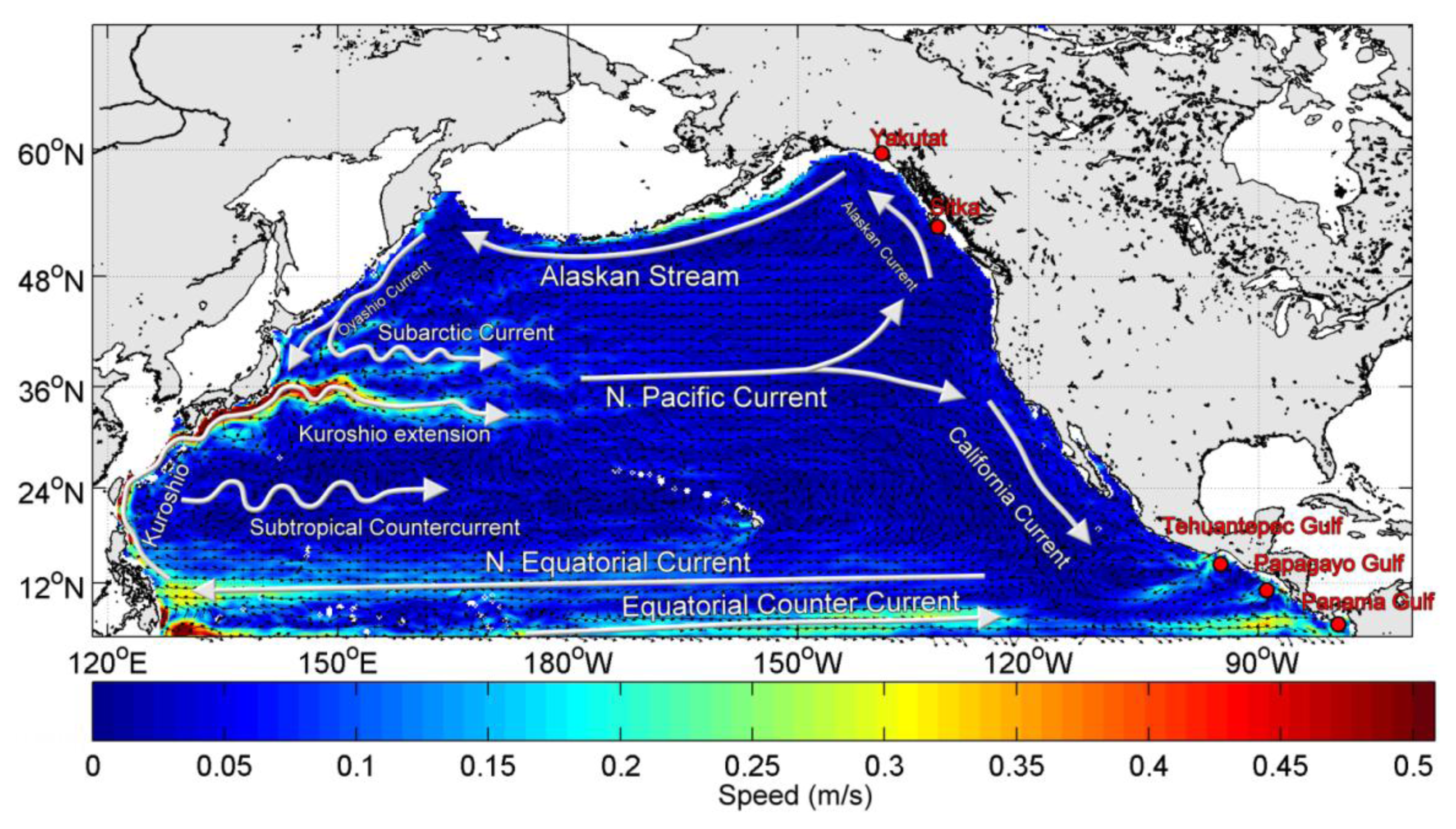
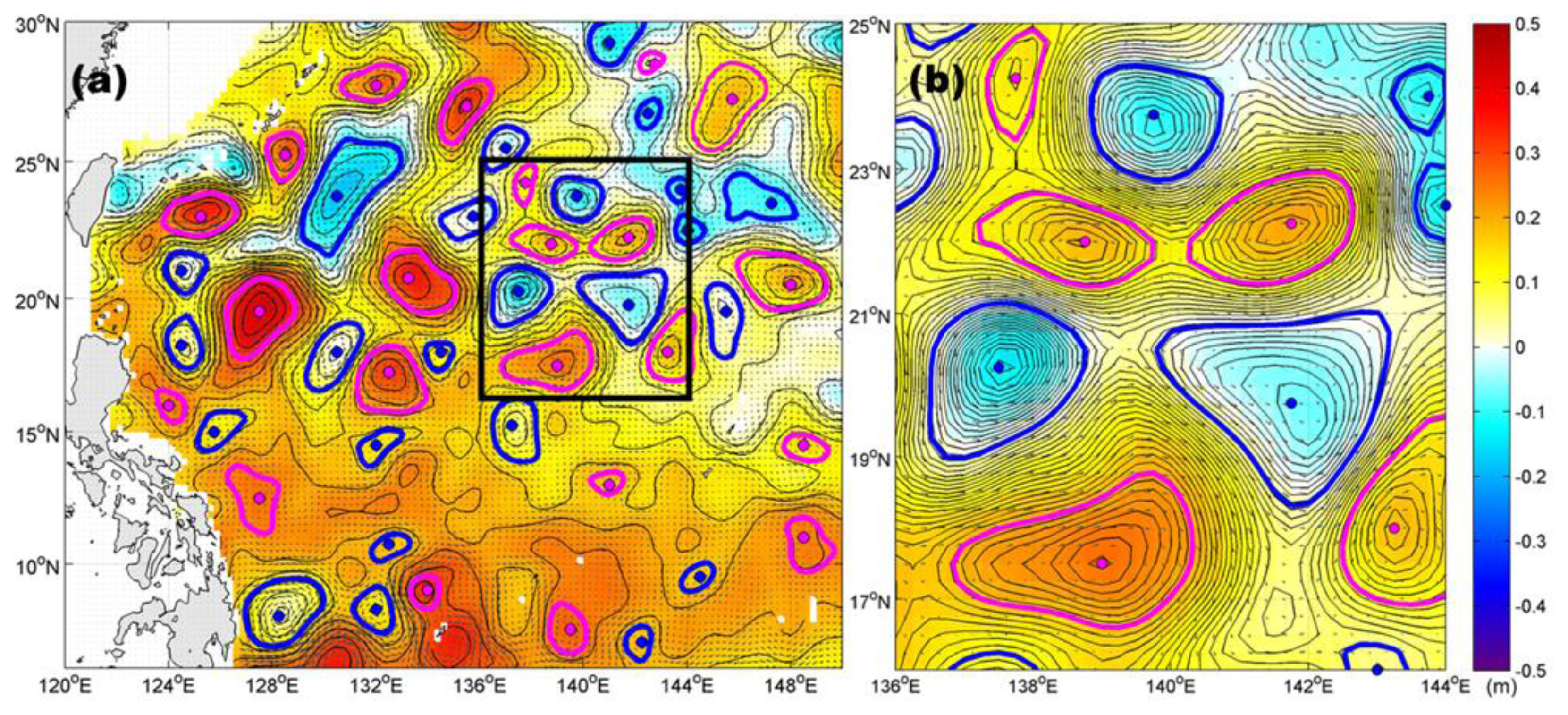


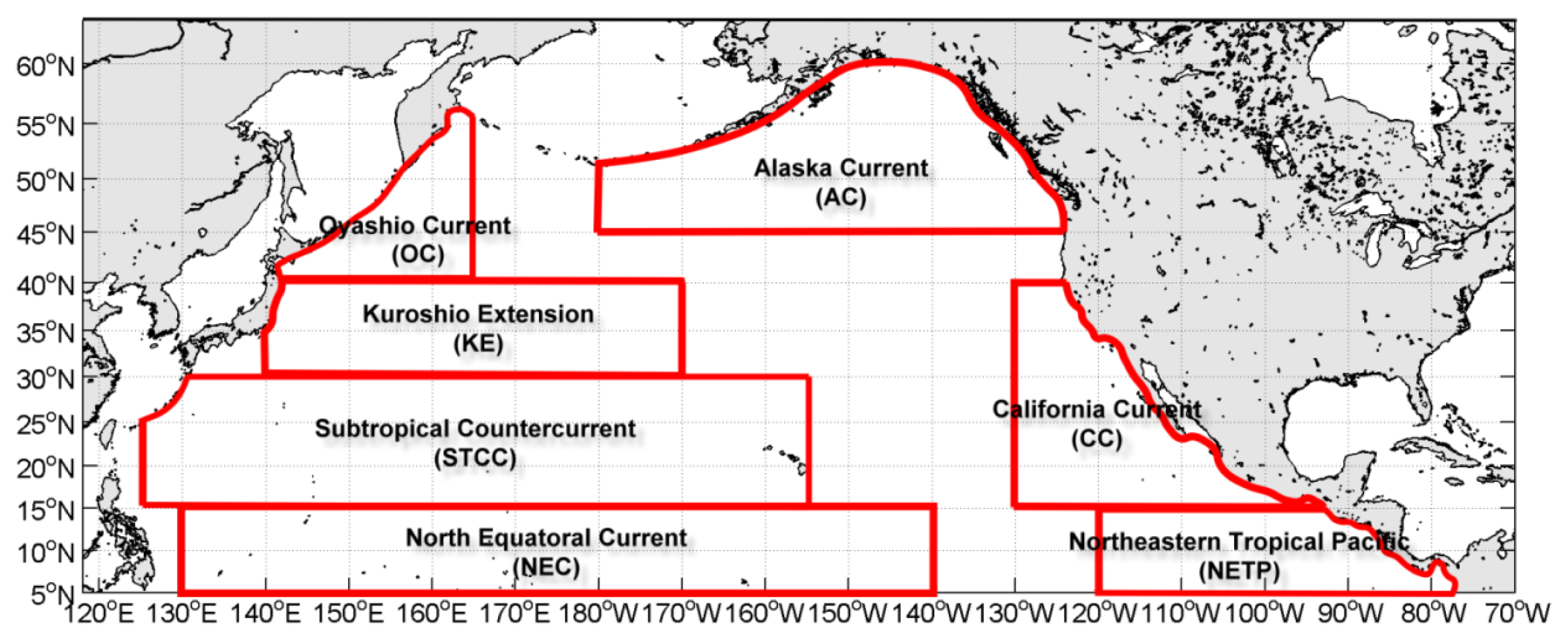

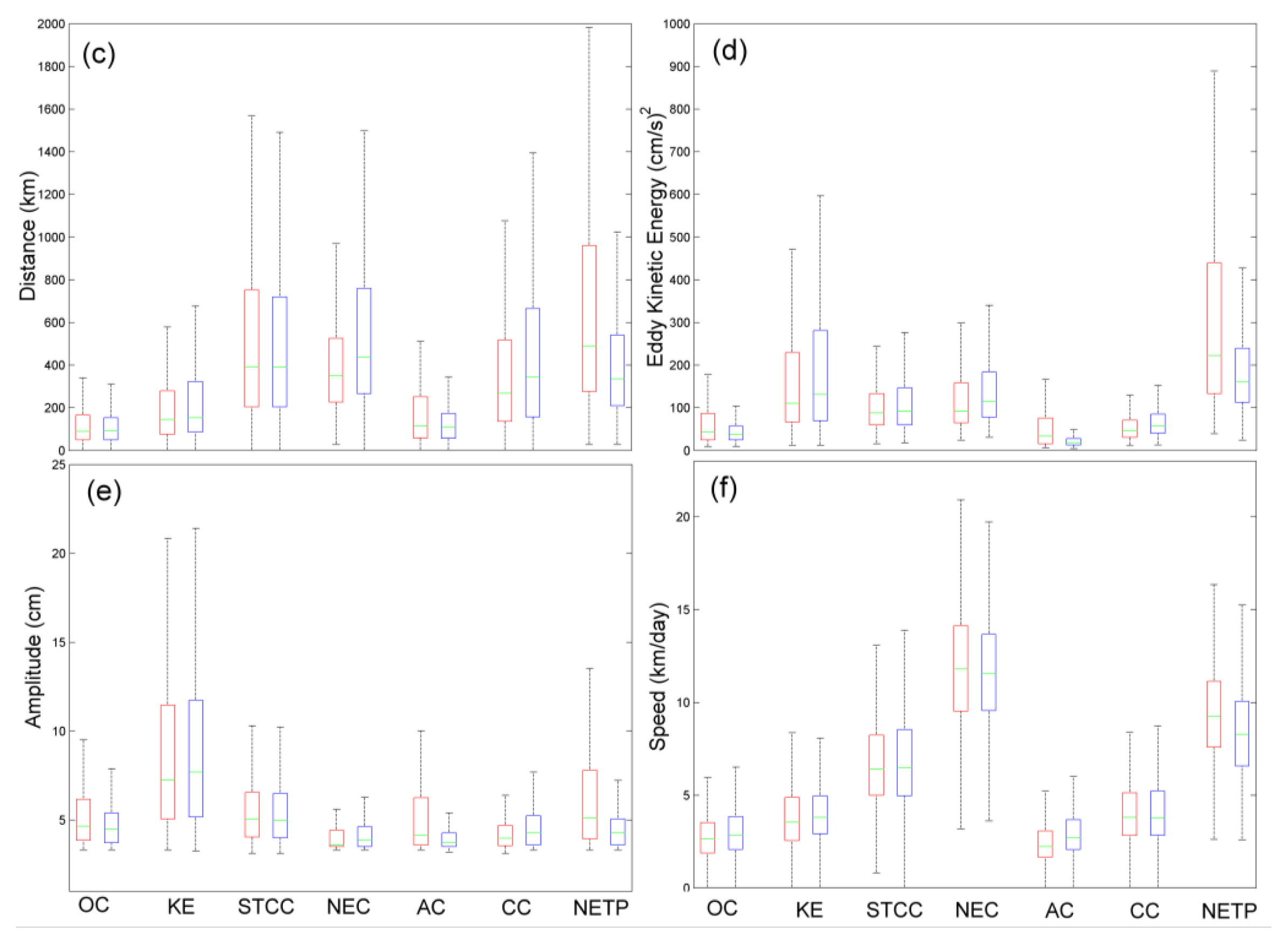
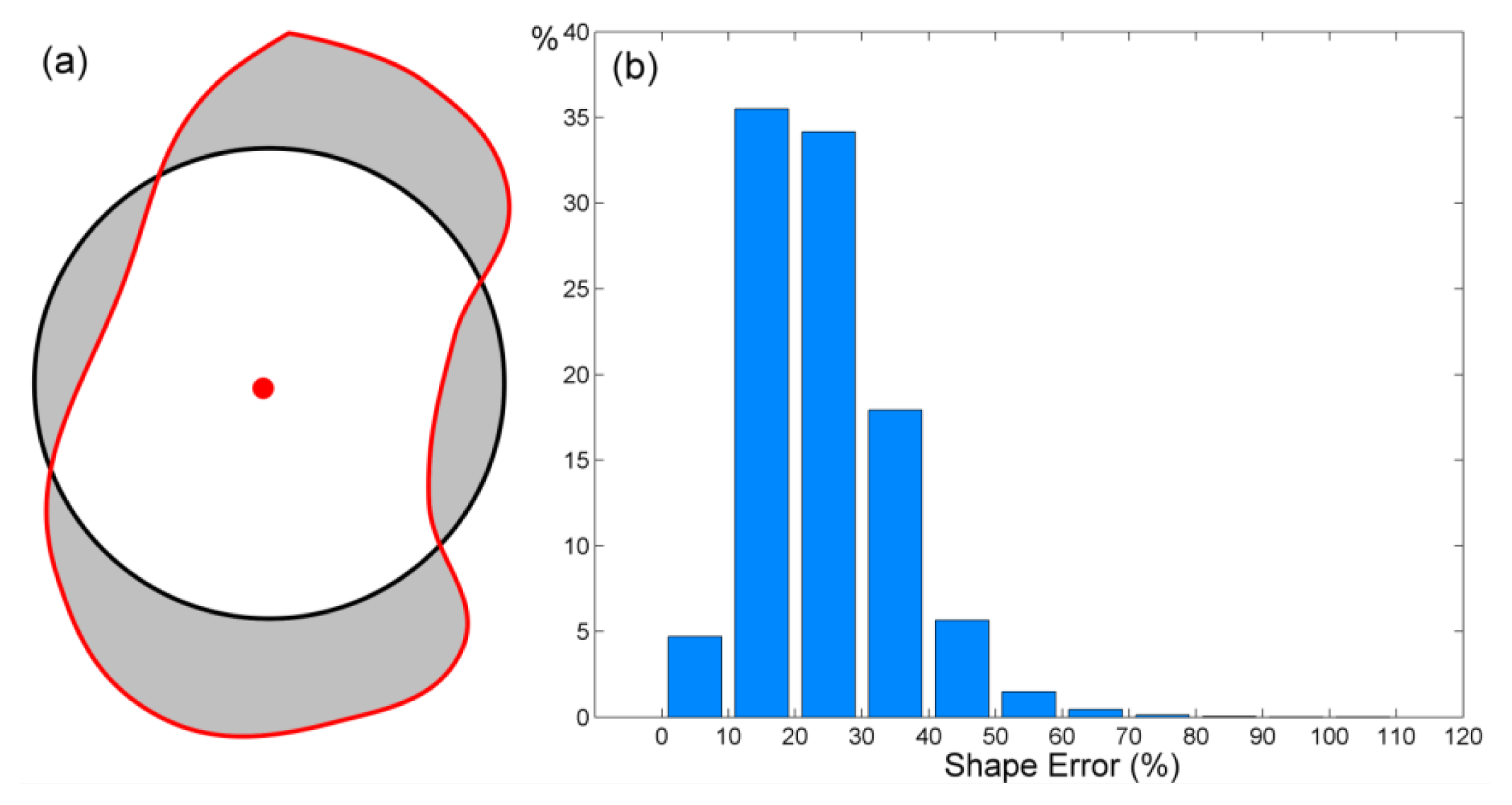
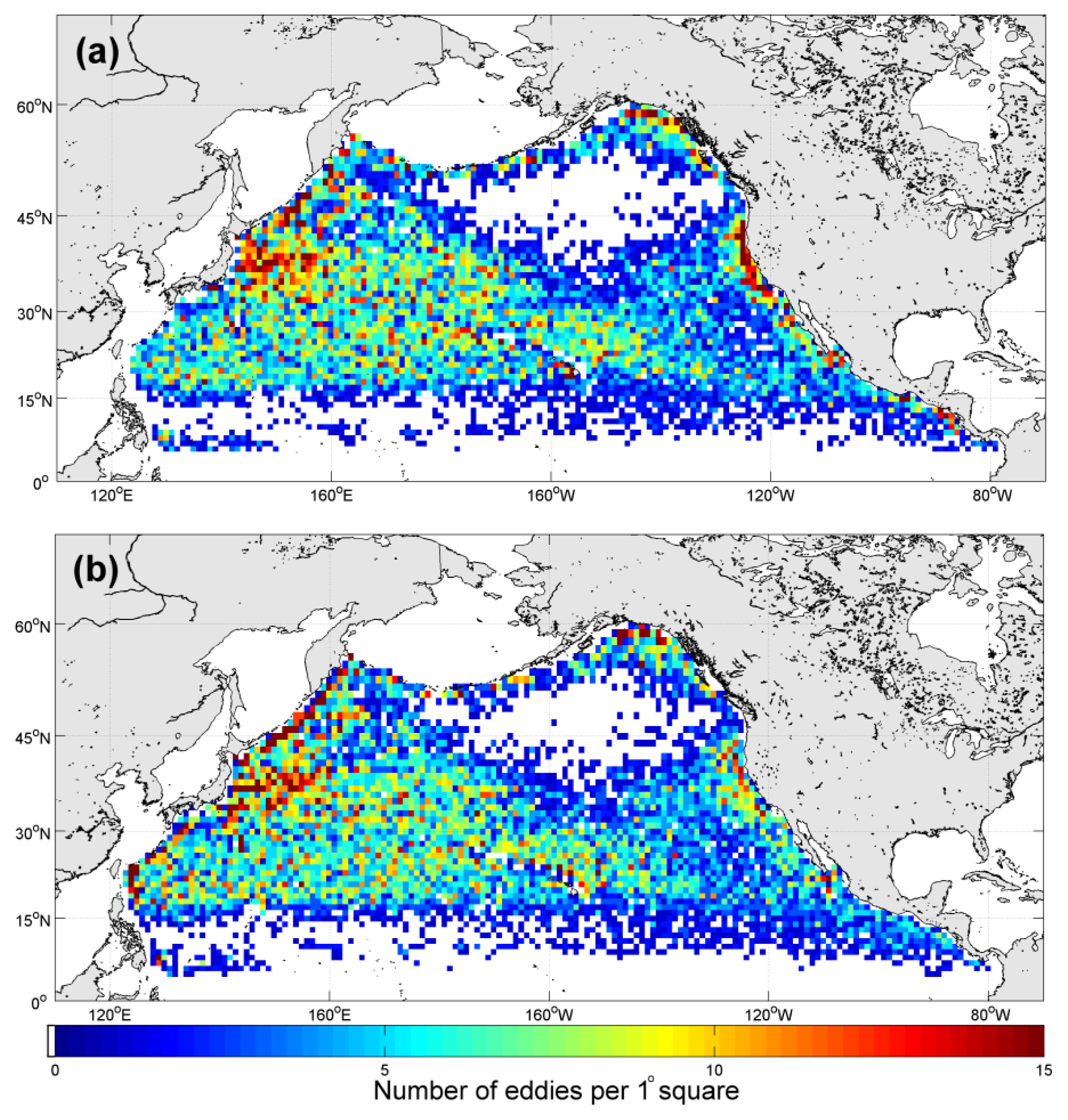
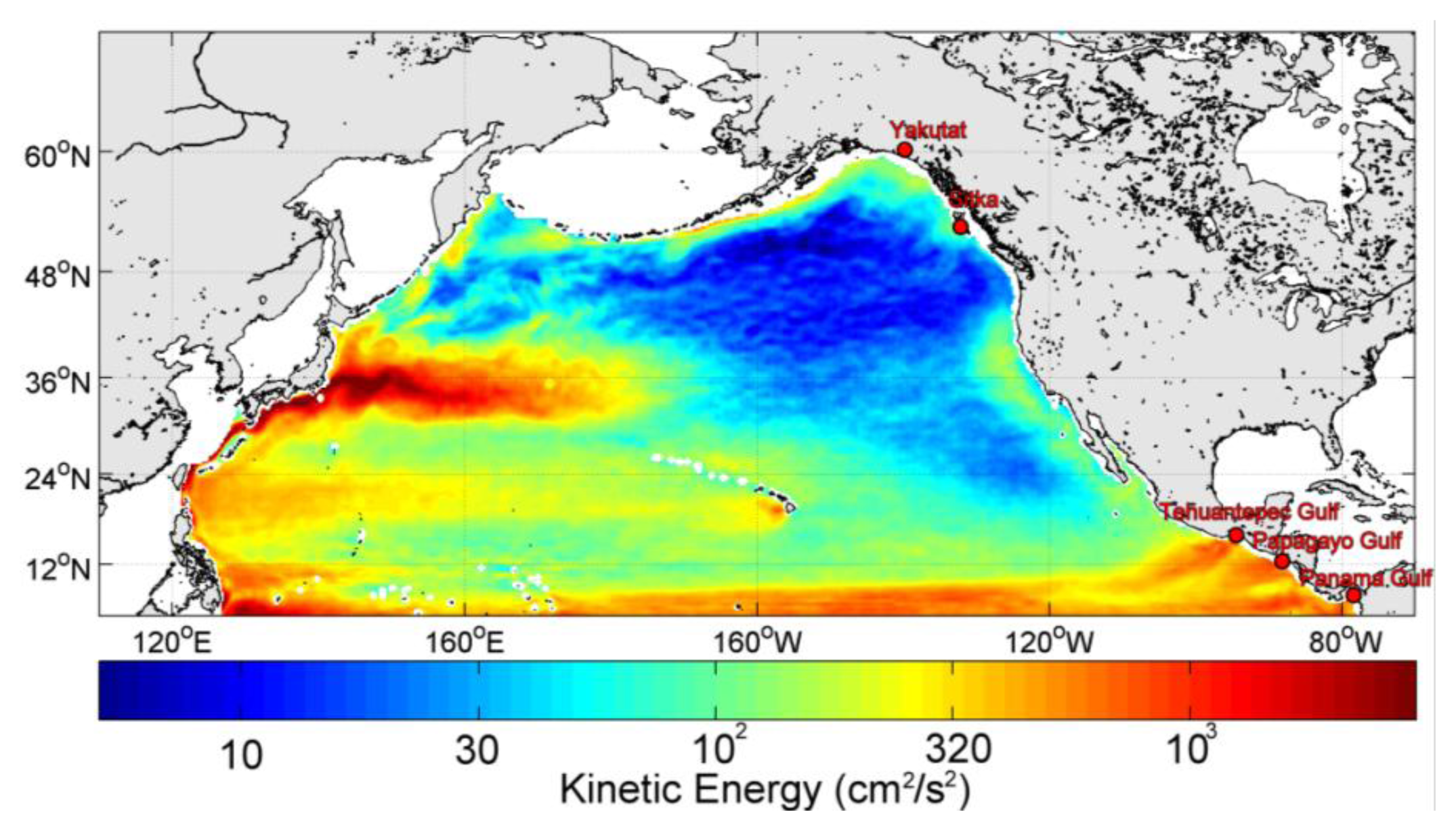

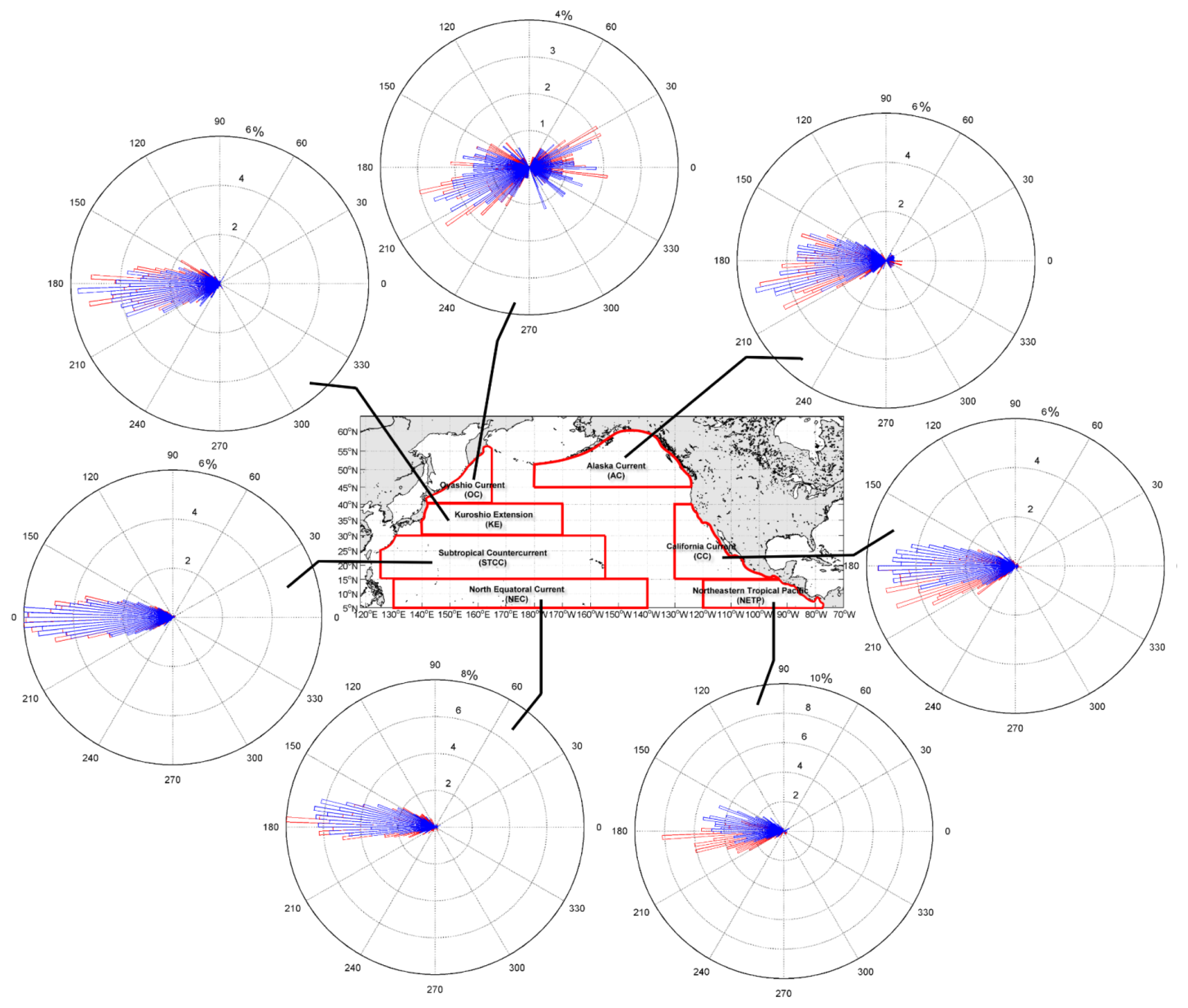
| Character | Number | Diameter (km) | Lifespan (week) | EKE (cm2/s2) | Distance (km) | Amplitude (cm) | Speed (km/day) | |
|---|---|---|---|---|---|---|---|---|
| Region | ||||||||
| OC | anticyclonic | 541 | 146 ± 24 (70, 232) | 18 ± 21 (4, 221) | 74 ± 76 (8, 449) | 123 ± 104 (0, 889) | 6 ± 2 (3, 18) | 3 ± 1 (0, 12) |
| cyclonic | 569 | 152 ± 22 (84, 248) | 16 ± 15 (4, 122) | 46 ± 32 (8, 297) | 116 ± 88 (0, 552) | 5 ± 1 (3, 14) | 3 ± 1 (0, 9) | |
| KE | anticyclonic | 1391 | 168 ± 32 (90, 282) | 19 ± 21 (4, 287) | 215 ± 262 (12, 1999) | 237 ± 290 (0, 3831) | 9 ± 6 (3, 46) | 4 ± 1 (0, 15) |
| cyclonic | 1505 | 162 ± 28 (80, 268) | 18 ± 16 (4, 163) | 282 ± 426 (11, 3867) | 269 ± 335 (0, 3649) | 10 ± 7 (3, 48) | 4 ± 1 (0, 10) | |
| STCC | anticyclonic | 2957 | 180 ± 32 (94, 344) | 17 ± 14 (4, 130) | 107 ± 69 (15, 817) | 592 ± 604 (0, 5734) | 6 ± 2 (3, 19) | 7 ± 2 (0, 18) |
| cyclonic | 3446 | 174 ± 30 (94, 312) | 15 ± 12 (4, 151) | 121 ± 107 (17, 2630) | 542 ± 499 (0, 4679) | 6 ± 2 (3, 49) | 7 ± 2 (0, 19) | |
| NEC | anticyclonic | 412 | 216 ± 36 (126, 364) | 7 ± 4 (4, 31) | 133 ± 111 (24, 832) | 416 ± 278 (27, 2066) | 4 ± 1 (3, 8) | 12 ± 3 (1, 21) |
| cyclonic | 691 | 212 ± 34 (132, 362) | 10 ± 9 (4, 112) | 148 ± 108 (31, 1133) | 612 ± 577 (0, 4989) | 4 ± 1 (3, 17) | 12 ± 3 (1, 23) | |
| AC | anticyclonic | 457 | 146 ± 24 (82, 220) | 27 ± 30 (4, 187) | 61 ± 73 (6, 463) | 204 ± 241 (0, 1771) | 5 ± 2 (3, 19) | 3 ± 1 (0, 10) |
| cyclonic | 415 | 164 ± 28 (90, 298) | 18 ± 13 (4, 94) | 23 ± 13 (4, 76) | 140 ± 124 (0, 1018) | 4 ± 1 (3, 7) | 3 ± 1 (0, 8) | |
| CC | anticyclonic | 900 | 176 ± 32 (86, 294) | 22 ± 19 (4, 135) | 70 ± 109 (10, 1135) | 423 ± 467 (0, 3545) | 4 ± 1 (3, 18) | 4 ± 1 (0, 13) |
| cyclonic | 965 | 170 ± 28 (94, 302) | 25 ± 19 (4, 130) | 70 ± 44 (13, 452) | 481 ± 464 (0, 5407) | 5 ± 1 (3, 11) | 4 ± 1 (0, 12) | |
| NETP | anticyclonic | 390 | 222 ± 36 (130, 320) | 14 ± 9 (4, 64) | 336 ± 294 (39, 1498) | 743 ± 704 (27, 4816) | 6 ± 3 (3, 18) | 9 ± 2 (2, 19) |
| cyclonic | 492 | 214 ± 38 (126, 344) | 10 ± 6 (4, 68) | 190 ± 117 (24, 910) | 418 ± 314 (27, 2219) | 5 ± 1 (3, 11) | 9 ± 2 (1, 20) | |
© 2014 by the authors; licensee MDPI, Basel, Switzerland This article is an open access article distributed under the terms and conditions of the Creative Commons Attribution license (http://creativecommons.org/licenses/by/3.0/).
Share and Cite
Cheng, Y.-H.; Ho, C.-R.; Zheng, Q.; Kuo, N.-J. Statistical Characteristics of Mesoscale Eddies in the North Pacific Derived from Satellite Altimetry. Remote Sens. 2014, 6, 5164-5183. https://doi.org/10.3390/rs6065164
Cheng Y-H, Ho C-R, Zheng Q, Kuo N-J. Statistical Characteristics of Mesoscale Eddies in the North Pacific Derived from Satellite Altimetry. Remote Sensing. 2014; 6(6):5164-5183. https://doi.org/10.3390/rs6065164
Chicago/Turabian StyleCheng, Yu-Hsin, Chung-Ru Ho, Quanan Zheng, and Nan-Jung Kuo. 2014. "Statistical Characteristics of Mesoscale Eddies in the North Pacific Derived from Satellite Altimetry" Remote Sensing 6, no. 6: 5164-5183. https://doi.org/10.3390/rs6065164




